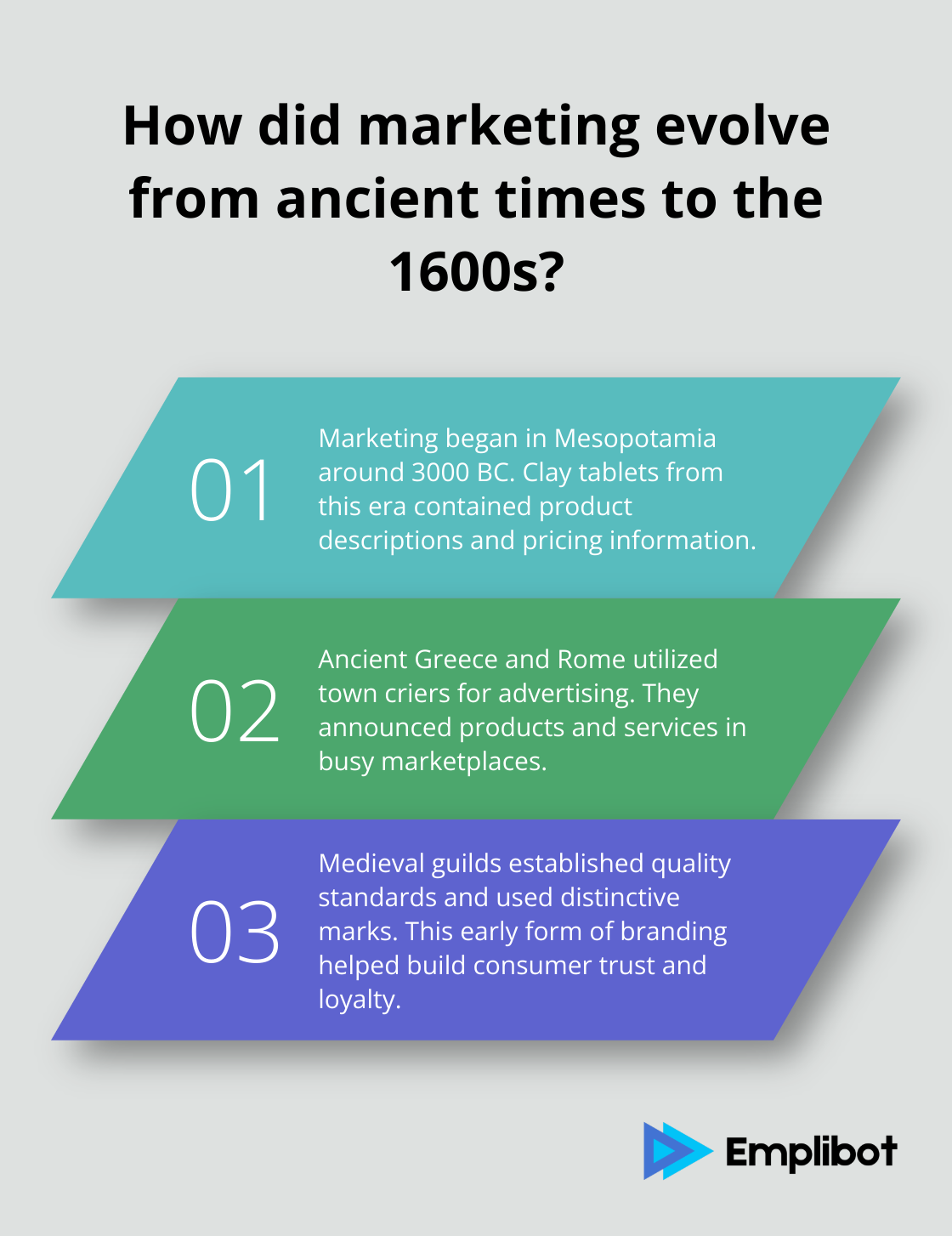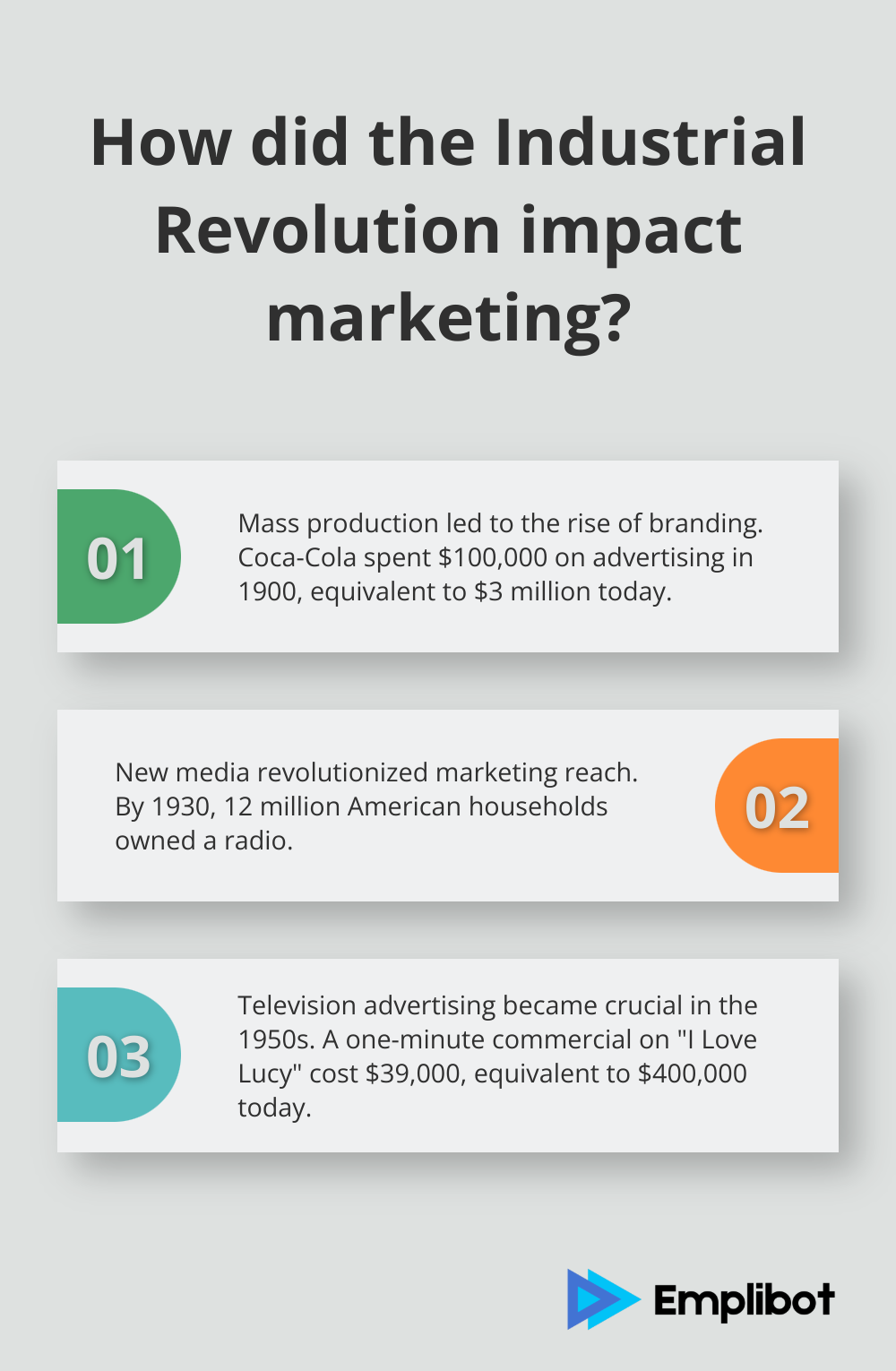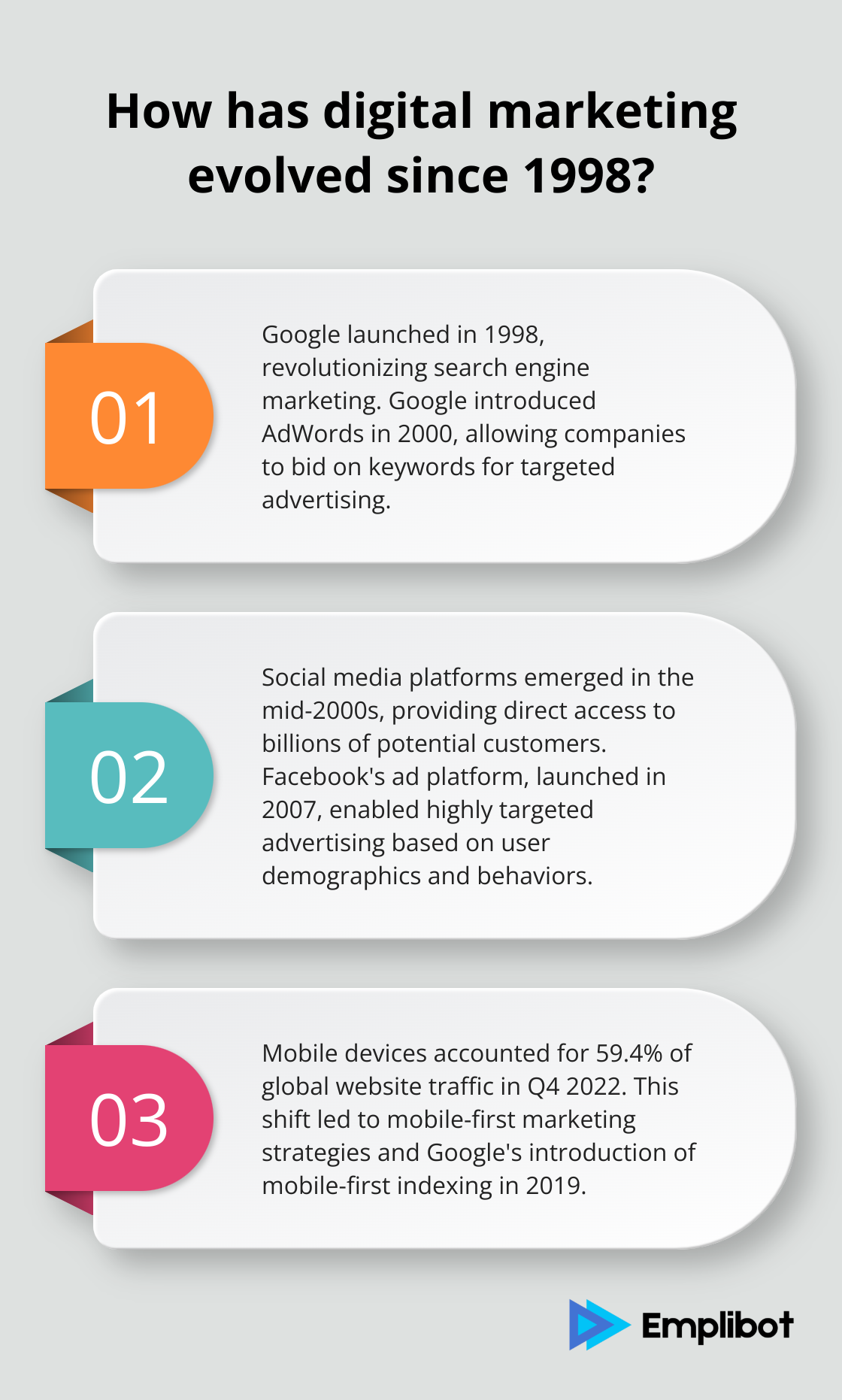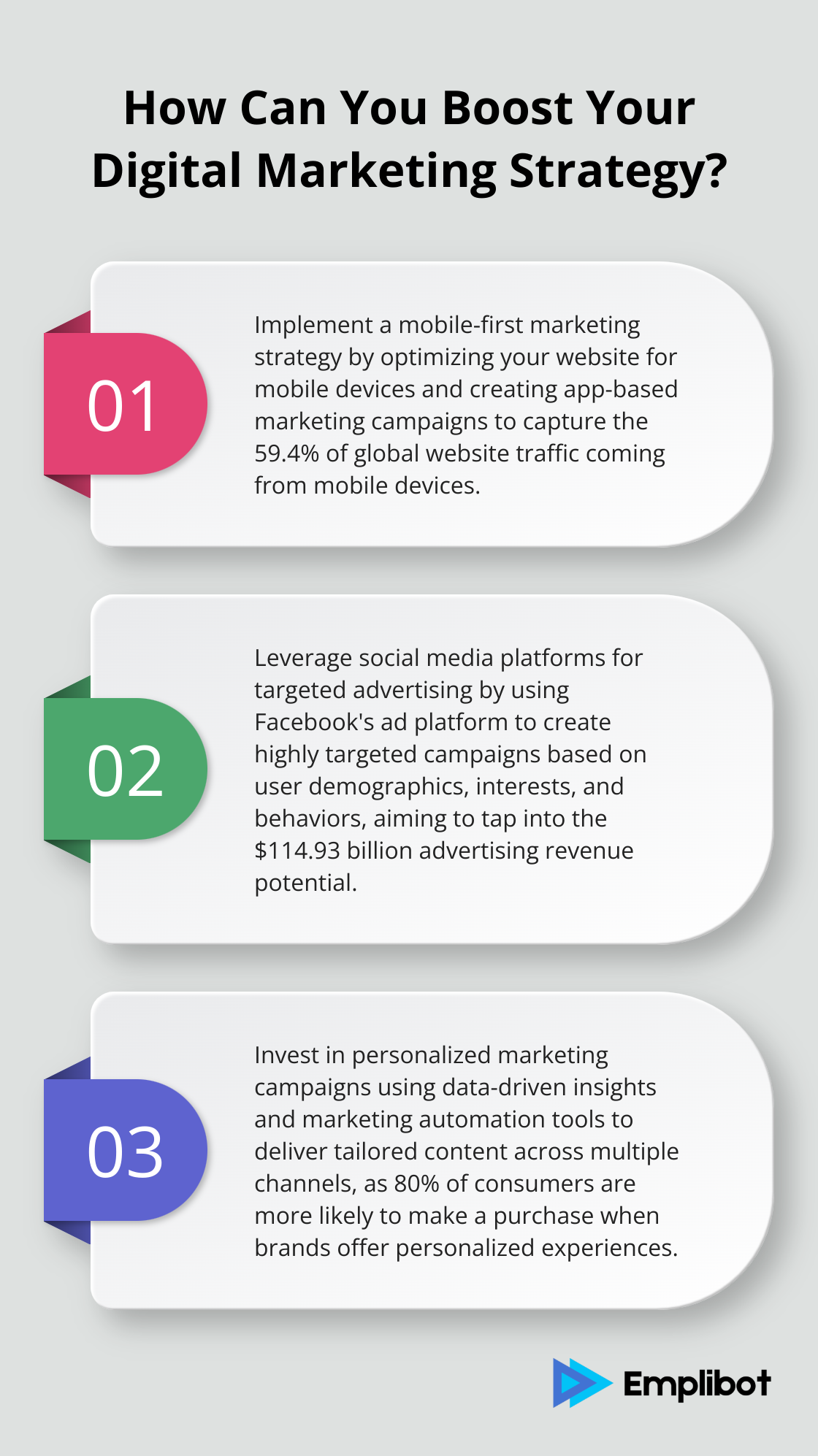Marketing has come a long way since its humble beginnings. At Emplibot, we’re fascinated by the history of marketing and how it has shaped our modern business landscape.
From ancient trade systems to today’s data-driven strategies, the evolution of marketing reflects the changing dynamics of human society and technology. This blog post will take you on a journey through time, exploring the key milestones that have defined the marketing industry as we know it.
How Did Early Marketing Shape Business?
Ancient Trade Systems: The Birth of Advertising
Marketing’s roots stretch back to the dawn of commerce itself. The earliest form of marketing emerged in ancient Mesopotamia around 3000 BC. Clay tablets from this era reveal simple product descriptions and pricing information – the first known examples of written advertising. These ancient merchants understood the power of differentiation, using unique symbols to mark their goods and build trust with customers.

In ancient Greece and Rome, town criers played a crucial role in spreading commercial messages. They shouted announcements about products, services, and public events in busy marketplaces. This early form of audio advertising demonstrates how marketers recognized the importance of reaching audiences where they gather.
Medieval Markets: Crafting Brand Loyalty
The Middle Ages saw the rise of market towns and trade guilds, which revolutionized marketing practices. Guilds established strict quality standards and used distinctive marks to identify their products. This early form of branding helped build consumer trust and loyalty – principles that remain central to effective marketing today.
Medieval markets also introduced the concept of product displays. Merchants arranged their goods attractively and called out to passersby, much like modern-day visual merchandising and sales techniques. These practices show how early marketers understood the importance of presentation and personal engagement in driving sales.
The Print Revolution: Marketing Reaches the Masses
The printing press, invented in 1440 by Johannes Gutenberg, marked a turning point in marketing history. This device allowed for the mass production of uniform printed matter, mainly text in the form of books, pamphlets, and newspapers.
By 1650, book advertisements became a regular feature of newssheets, sometimes including brief comments. Regular catalogs also began to appear, as noted by Britannica. This development allowed businesses to reach wider audiences more efficiently than ever before.
These early marketing practices laid the foundation for many strategies we still use today. From building brand trust to leveraging new technologies, the core principles of effective marketing have remained surprisingly consistent throughout history (despite the passage of time).
As we move into the next era of marketing history, we’ll explore how the Industrial Revolution transformed these foundational practices and gave birth to modern consumerism. The mass production of goods and the rise of new communication technologies would soon revolutionize the way businesses reached and engaged with their customers.
How Did the Industrial Revolution Transform Marketing?
The Industrial Revolution marked a seismic shift in marketing practices, ushering in an era of mass production and consumerism that transformed how businesses reached their customers. After the Civil War, consumer mindset was increasingly shaped by the availability of mass-produced goods brought about through technological improvements. This period saw the birth of many marketing techniques we still use today, albeit in evolved forms.
Mass Production and the Rise of Branding
The ability to produce goods on a massive scale created a need for more sophisticated marketing strategies. Companies had to differentiate themselves in increasingly crowded markets. This led to the rise of branding as we know it today.

One of the earliest examples of successful branding during this period was Coca-Cola. Founded in 1886, the company quickly recognized the power of consistent messaging and visual identity. In 1900, Coca-Cola spent $100,000 annually on advertising (equivalent to about $3 million today). This early investment in brand building paid off – Coca-Cola remains one of the world’s most recognized brands over a century later.
The Power of New Media
The advent of radio and television revolutionized marketing, offering unprecedented reach and engagement. Radio advertising began in the 1920s, with the first paid radio ad airing in 1922. In 1930, 12 million American households owned a radio, providing a massive audience for marketers.
Television followed suit, with the first TV ad airing in 1941. It was a 10-second spot for Bulova watches, costing just $9. The 1950s saw TV advertising become a cornerstone of marketing strategies for major brands. The famous “I Love Lucy” show, which debuted in 1951, charged $39,000 for a one-minute commercial (equivalent to about $400,000 today).
These new mediums allowed for more creative and engaging advertising. Jingles, catchphrases, and visual storytelling became powerful tools in the marketer’s arsenal. The “I’d Like to Buy the World a Coke” campaign from 1971 is a prime example, combining a catchy tune with a message of unity that resonated globally.
The Science of Marketing
The Industrial Revolution also saw the birth of modern market research and segmentation. Companies began to realize the importance of understanding their customers on a deeper level.
In 1923, Daniel Starch developed the Starch test, one of the first methods for measuring advertising effectiveness. This technique involved interviewing magazine readers to determine which ads they remembered and how they felt about them. It’s still used today in modified forms.
A.C. Nielsen founded his market research company in 1923, introducing the concept of market share. The 1950s saw Nielsen provide crucial data on radio and television audiences, helping marketers make more informed decisions about ad placements.
The concept of market segmentation emerged in the 1950s, with Wendell Smith’s seminal paper “Product Differentiation and Market Segmentation as Alternative Marketing Strategies.” This approach allowed companies to tailor their marketing efforts to specific groups of consumers, increasing efficiency and effectiveness.
As we move into the digital age, these foundational principles continue to evolve, adapting to new technologies and changing consumer behaviors. The next chapter will explore how the internet revolution and the rise of social media have further transformed the marketing landscape, creating new opportunities and challenges for businesses of all sizes.
How Digital Marketing Revolutionized Business
The Birth of Search Engine Marketing
The launch of Google in 1998 marked a turning point in digital marketing. As internet usage exploded, businesses quickly recognized the potential of search engines to drive traffic and sales. Google introduced AdWords in 2000, which allowed companies to bid on keywords and display ads alongside search results.

This pay-per-click model transformed advertising, offering a level of targeting and measurability previously unattainable. The Search Advertising market worldwide is projected to grow by 8.30% (2025-2029) resulting in a market volume of US$483.50bn in 2029, highlighting its continued importance in modern marketing strategies.
Social Media: A New Marketing Frontier
The mid-2000s witnessed the rise of social media platforms like Facebook, Twitter, and LinkedIn. These networks provided businesses with direct access to billions of potential customers, fundamentally altering how brands interact with their audience.
Facebook’s ad platform, launched in 2007, enabled highly targeted advertising based on user demographics, interests, and behaviors. Meta (formerly Facebook) reported advertising revenue of $114.93 billion in 2021, demonstrating the massive scale of social media marketing.
Influencer marketing emerged as a powerful strategy on these platforms. A survey by Influencer Marketing Hub found that businesses earn an average of $5.78 for every dollar spent on influencer marketing, making it an attractive option for many brands.
The Power of Data-Driven Personalization
The digital era has given marketers access to unprecedented amounts of consumer data. This wealth of information allows for highly personalized marketing campaigns tailored to individual preferences and behaviors.
A study by Epsilon found that 80% of consumers are more likely to make a purchase when brands offer personalized experiences. This trend has led to the development of sophisticated marketing automation tools that can deliver personalized content across multiple channels.
Mobile Marketing Takes Center Stage
The widespread adoption of smartphones further transformed digital marketing. Statista reported that mobile devices accounted for 59.4% of global website traffic in the fourth quarter of 2022.
This shift necessitated mobile-first marketing strategies, including responsive web design, app-based marketing, and location-based targeting. Google’s introduction of mobile-first indexing in 2019 underscored the importance of mobile optimization for search engine visibility.
Emerging Technologies Shape the Future
As we look to the future, emerging technologies like augmented reality (AR) and virtual reality (VR) promise to open up new avenues for immersive marketing experiences. The key to success in this rapidly evolving landscape will be adaptability and a willingness to embrace new technologies and strategies as they emerge.
Final Thoughts
The history of marketing reveals constant adaptation to consumer needs and technological advancements. Successful marketers have always prioritized customer experience, from medieval merchants to modern brands leveraging data for personalization. Embracing new technologies has proven crucial for staying competitive, as seen with the printing press in the 15th century and the internet in recent decades.

Strong branding has commanded customer loyalty throughout marketing history, from guild marks to iconic campaigns. The future of marketing will likely involve artificial intelligence, augmented reality, and the Internet of Things, creating new opportunities for consumer engagement. Marketers must balance these technologies with authentic connections and respect for individual data rights.
At Emplibot, we help businesses navigate the complexities of digital marketing. Our automated content marketing solution enables companies to maintain a strong online presence without sacrificing quality. The ability to adapt, innovate, and connect with audiences will continue to define successful marketing strategies in the years to come.

